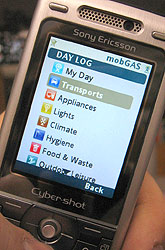
In the past, I've been a bit sniffy about carbon calculators and have tended to dismiss them, although if I'm honest it's been on principle rather than first-hand experience. From what I've seen, they oversimplify an incredibly complex issue and, as a colleague pointed out, shift the weight of responsibility onto individuals when it should be an energy-efficient government that leads the way.
But then I came across mobGAS, a calculator produced by the European Commission's Joint Research Centre which sits on your mobile phone and allows you to enter daily updates about your energy consumption. Hurray, a new application for me to fiddle with in a borderline obsessive-compulsive manner, and an excuse for a broader look at carbon calculators in general.
So, for the next few weeks I'll be using mobGAS to log my emissions (stop sniggering at the back). This calculator requires you to enter extensive details about your activities on a daily basis, so I want to see just how far I'll need to go to build a picture of my own contributions to climate change, as well as weighing up the pros and cons of this and other carbon calculators along the way. Not in terms of accuracy sadly (a whole research team could spend months doing that), but more to see what value they have as a tool to encourage low-carbon lifestyles.
To start with, I had to set up mobGAS and despite crashing my phone every now and then, it's quite a nifty little piece of work that's reasonably easy to use but some more help options wouldn't go amiss. It allows you to establish general settings for your typical day which can be augmented with specific details about your energy use, and produces results for carbon dioxide, nitrous oxide and methane emissions.
As I burrowed further into it, it became clear just how much detail I'm going to have to log in order to do this self-imposed project justice. Initial questions about my home had me wielding a measuring tape to find out the area in square metres of my flat and garden.
Entering details about the various electrical appliances I use day-to-day starts to get even more complex - there's room to add almost anything you can think of and, in most cases, you're able to enter the actual power consumption in watts. I managed to get the information about my own techno-junk from manuals lying at the bottom of various drawers, but my TV dates back to pre-1990 and if I ever had it, the manual is long gone. It's a cathode ray portable so I'm going to gamble on it being a relatively low power-eater but totting up how much it gets used on average just gets embarrassing.
Then there are the lights. I could, if I wanted, add details about every single bulb in the flat and I did start checking the wattage of each CFL. But after inadvertently breaking one (which of course will now have to be disposed of in the proper fashion) and finding a rogue incandescent lurking under the kitchen units, I entered details about the two or three lights which are used most before calling it a day.
So, with my typical day set up, I began adding the individual items from my first day of carbon awareness. There was the microwave I used for three minutes to heat up my lunch, the radio I listened to while cooking, and the kettle I boiled. This particular calculator - like all of them I've seen so far - leans towards domestic, personal use and doesn't prod you to add energy used at work. But as my work computer is on for eight-plus hours a day and wouldn't be here if I weren't employed in this particular office, it feels unfair not to include it in my daily totals.
Adding the bus journey in to work required some additional research as it asks for the distance (something I've guessed about but not actually checked out) and the type of bus I rode on: diesel, trolley, bio or LPG. To be honest, I've no idea and it never occurred to me to check. But as there are only a handful of hydrogen fuel cell buses in London, and the diesel hybrids don't run on my route, I'll have to assume it was of the regular diesel variety. For those who live in higher latitudes, there's the option of adding your journeys by snowmobile.
Likewise the household rubbish: where does it go? Hackney's website wasn't very revealing although I did find a waste and recycling strategy (pdf) from 2004 which mentions landfill. However, a call to the environmental services team tells me that everything goes to the incinerators at Edmonton and Alperton, although I'm not sure which of the two evils is more preferable.
It's only day one and already, slavishly inputting my energy consumption is beginning to feel irritating at best, anally retentive at worst. I'm also irked that I can't include anything about the swim I had at my local, brightly-lit and overheated leisure centre. That would be one of those pesky indirect emissions, more on which next week.

